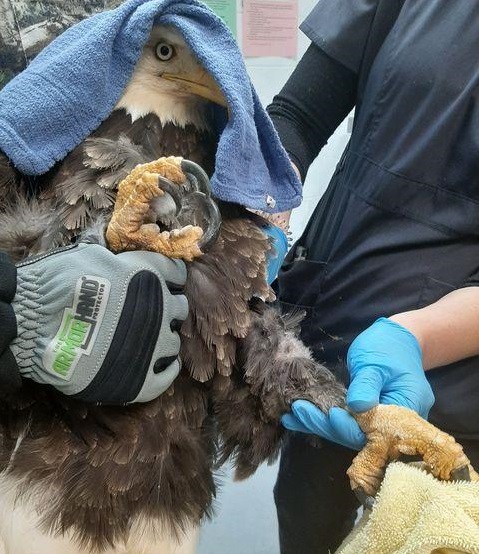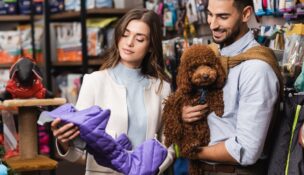Veterinarian Turns Injury into Pet Care Industry Tool
Glenn Polyn //December 31, 2020//
Working with animals has been a fulfilling career choice for me. As a veterinarian, I’m able to provide care and compassion to my patients while maintaining and improving their quality of life. After completing four years of veterinary school, I started working at an emergency practice in Pennsylvania. The cases that I saw varied from routine wellness exams to hit-by-cars as well as toxin ingestion, so each day was unlike the one prior.
What I realized early on during my veterinary career was that, at times, we need personal protection. Animal caregivers—whether veterinarians, groomers, wildlife rehabbers, pet owners, shelter workers, zoo employees or animal control—are at a higher risk of injury from bites and scratches. Historically, in practice, we had bulky welding gloves available to us when we needed protection. Yet, we were not wearing the gloves because they prevented us from doing our job successfully. First, welding gloves are made of leather, which cannot be washed. When working with animals, it is vital to use a glove that is machine washable in order to decrease the risk of infectious disease transmission.
Second, welder gloves are extremely bulky, making it impossible to perform proper restraint technique. Additionally, because of the bulkiness, the gloves severely lacked flexibility and dexterity – this hindrance prevented us from restraining compassionately as well.
As a result, like others in my profession, I did not wear the welder gloves available to us, and ultimately this resulted in a potentially career-ending bite injury from a feline patient when it latched on to my left thumb. I took the standard course of action, which included a visit to the ER, soaked my hand in antibacterial solution and was discharged with oral antibiotics. Bites and scratches occur on a daily basis when working with animals, so I did not think the severity of this injury would differ from any previous injuries.
The next morning I woke up and realized that the infection had spread from my thumb all the way up my arm to the left side of my neck. My hand was swollen, and I could not move it. I went back to the hospital and was ordered to have emergency surgery; my joints had become septic. The infection was not localized anymore and was spreading throughout my body. A PICC line was placed in my right arm. I was in a severe amount of pain and extremely concerned how this injury would not only affect my long-term health, but also my ability to practice medicine again.
I was in the hospital for seven days. Upon being discharged, I had to undergo extensive and painful physical therapy for seven months in order to attempt to regain use of my left hand.
Because of my injury, I became even more aware of the need for a glove that animal caregivers would wear. My profession needed a glove that would offer protection as well as superior flexibility and dexterity. I envisioned a product that would offer so much dexterity that it would be compatible with low-stress handling techniques as well as Fear Free handling. Additionally, I knew the materials would need to be machine washable in order to decrease the risk of infectious disease transmission, which is a risk when working with animals.
I started contacting different glove manufacturers through Google searches. I described the problem that the veterinary community faced; the lack of adequate personal protective equipment. Many companies simply were not interested. They did not understand the severity of the problem, or they were not looking to develop a new product at the time, but I persisted. I remember one phone call that I made to a glove company based in California. We talked at length and many emails were sent back and forth over the next year. The process was that I would describe what I needed as well as the materials that were of interest to me. The company would then send me a prototype. I would test the gloves on my patients and provide my feedback. This process went on for nearly 3 years. Nearly 20 different prototypes were developed and once I knew that we had the perfect product, the gloves were then tested by zoo employees, groomers and other veterinary professionals. The ArmOR Hand Animal Handling Gloves were perfected and two styles were developed.
Veterinary sales started in the US and then expanded internationally. Wildlife distributors were also ordering and the gloves became (and still are) one of their best selling products. Because it was so important to me to have a glove that could achieve compassionate handling techniques, my next mission was to achieve a Fear Free Preferred Product status for ArmOR Hand. I contacted Dr. Marty Becker and was instructed to send gloves to some of the top animal behaviorists in the US. The gloves were tested by these professionals and were ultimately awarded the Fear Free status.
ArmOR Hand is an extremely unique product. It was important for me that these gloves would be comfortable enough for animal handlers to wear – because personal protective equipment is useless if we do not wear it. The ArmOR Hand Gloves are made of the strongest of the stretch materials, including a double layer of DuPont-knit Kevlar. The gloves are sized to ensure a proper fit, they offer superior flexibility and dexterity, and are water resistant and machine washable. ArmOR Hand has received tremendous praise from animal caregivers all over the world, and the gloves are changing the way that we can provide care for our patients.
As a profession, we need to be more proactive about protecting ourselves and utilizing personal protective equipment. By using ArmOR Hand, I am able to safely and properly restrain and provide the best medical care. ArmOR Hand started as an idea because I was not content with the status-quo of what was available to my profession. The journey of product development was not easy—there were many road bumps, as well as a considerable amount of expense, but the years of dedication, hard work, and passion behind the product, has made the journey well worth it. It is important for any visionary not to settle for what is status-quo but to persist to make their vision a reality.



















